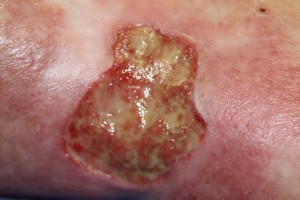For a number of years I have been presenting a lecture entitled “Differentiating infected from non-infected wounds”. As part of that talk I discuss the role of topical antimicrobials in wound healing. Despite there being a countless number of silver impregnated dressings along with multiple other antimicrobial dressings and solutions filled with all different types of product there is little evidence to support that their antimicrobial activity does, in fact, contribute to wound healing. We know that wounds become contaminated with multiple bacteria and we know that at least some of these organisms are capable of forming biofilm over the wound bed. It is felt that the presence of these organisms sets up a low-grade chronic inflammatory process that produces byproducts such as MMPs which inhibit wound healing. The thought behind using a topical antimicrobial is to kill these organisms thus allowing for improved healing. This certainly makes empirical sense since we have always been taught that these bacteria on a wound have to be bad. In my mind, however, there are three questions that should be adequately answered before we haphazardly continue using these dressings.
1. Does the use of a topical antimicrobial decrease the wound of bioburden?
2. By decreasing the wound of bioburden do we hasten wound healing?
3. By decreasing the wound of bioburden do we prevent colonized wounds from becoming clinically infected?
Surprisingly, really none of these questions have been answered to my satisfaction. For this particular discussion I will concentrate on question #2. An interesting study entitled “Bacterial burden and wound outcomes as influenced by negative pressure wound therapy” with just published in the February 2010 issue of Wounds by Boone, Braitman, Gentics, et.al out of St. Luke’s – Roosevelt Hospital in New York City. In this small pilot study using a porcine wound model infected wounds were created using a combination of bacteria including Pseudomonas, Staphylococcus and Bacteroides, and then treated with V.A.C. therapy using either regular or silver impregnated foam along with a moist wound dressing control. Both quantitative and semi-quantitative bacterial cultures were performed. To quote the Abstract “The wounds continue to show gross and microscopic improvement when treated with standard NPWT and NPWT with silver compared to moist wound care controls. However, the bacterial burden in all wounds continued to increase and broaden to include local skin flora, which had been absent immediately after wounding.” The authors concluded that the improvement in healing of the wounds could not be explained by a change in their bacterial burden.
The results of this study are actually similar to some of the earlier work performed using the V.A.C. Wounds healed more rapidly when the device was applied yet, almost paradoxically, the bioburden of the healing wounds seemed to increase rather than decrease as the wounds continued to heal. This certainly seems counterintuitive to the entire concept that the bacteria are somehow inhibiting wound healing. Maybe this all points to the ancient concept of “laudable pus”! Of course many factors must be considered. Probably more important than the number of bacteria is which types of bacteria are actually present. Certainly there is a difference in pathogenicity of some bacteria over others. Also of interest in this study is that the silver impregnated foam did not decrease the bioburden any more than the standard foam (question #1 anybody?)
Please do not take that to mean that I am somehow “dissing” all antimicrobial wound products. I certainly use them and will continue to in the foreseeable future. The bottom line to this entire discussion is that, although we are programmed to feel that somehow all bacteria in wounds are detrimental, perhaps the presence is not always necessary to eliminate. Before we jump on any bandwagon promoting the “latest and greatest” in antimicrobial wound therapies perhaps we should step back and ask the three critical questions I posed above. By prodding industry to produce high levels of evidence-based medicine it can only improve our overall treatment of these difficult patient problems.


